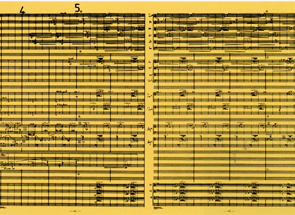|
|
 |
 |

|
 |
 |
Partitur
"Diadèmes" by Marc André Dalbavie wants to point out the relations between the electronic world and the traditional world of instrumental music.
"Diadèmes" is a commissioned work for the Ensemble Itinéraire and was composed in 1984. Its aim is to point out the possible relations between the electronic (numerical) world and the traditional world of instrumental music.
As such it follows the track laid by "Les Miriors Transparents" for orchestra (1983 / 85) written for the festival of Metz, where the harmonic material is strongly influenced by the possibilities offered by computer controlled sound processing. The tonal colours of the traditional instruments were defined as well as the timbre of the synthesizers. Thus the instrumental sound and the synthesis blend into each other in the course of performance, which makes it rather difficult to find out which part of the sound material is "real" and which is synthetic.
Three different kinds of numeric material were used for "Diadèmes". The composition supporting software was processed on an Apple Macintosh computer, the programmes used were Le lisp (Chailloux) and sound extension FORMES (IRCAM; Lee Boynton) allowing for a "filtration" of the generation processes through harmonic rules.
The synthesis part was crated on two Yamaha TX 816 controlled by two Yamaha KX 88. The frequency modulations applied were controlled by the Macintosh through programmes by IRCAM.
The transformation part was controlled over a couple of harmonizers that calculated the sound and transposed it in real time, furthermore an echo and digital reverb unit was used.
Source: Marc André Dalbavie
Cross-reference: The right to reprint is reserved for the press; no royalties will be due only with proper copyright attribution.
 download
printversion download
printversion
 back
back
|
 |
|